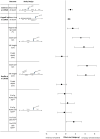The Potential of Fasting and Caloric Restriction to Mitigate Radiation Damage-A Systematic Review
- PMID: 33072801
- PMCID: PMC7530334
- DOI: 10.3389/fnut.2020.584543
The Potential of Fasting and Caloric Restriction to Mitigate Radiation Damage-A Systematic Review
Abstract
Detrimental health effects from ionizing radiation to living organisms is one of the key concerns identified and addressed by Radiation Protection institutions, nationally and internationally on Earth and for human spaceflight. Thus, new methods for mitigating the adverse effects of ionizing radiation are urgently needed for terrestrial health and deep space exploration. Caloric restriction and (intermittent-) fasting have been reported to elicit a variety of immediate and long-term physiological effects. The rapidly growing body of evidence of research studies investigating the effects of caloric restriction and dietary fasting points toward a multitude of benefits affecting numerous physiological systems. Therefore, a systematic review was performed to evaluate the evidence of caloric restriction and dietary fasting on the physiological response to ionizing radiation in humans and animals. All experimental studies of humans, animals, and eukaryotic cell lines available in PubMed, Cochrane library, and specialized databases were searched comparing irradiation post-caloric restriction or fasting to a non-nutritionally restricted control group on a broad range of outcomes from molecular to clinical responses. The initial search yielded 2,653 records. The final analysis included 11 studies. Most studies investigated survival rate or cancer occurrence in animals. Included studies did not reveal any benefit from pre exposure caloric restriction, except when performed with post radiation caloric restriction. However, the effects of pre-exposure fasting suggest increased resilience to ionizing radiation.
Keywords: SIRTUIN; caloric restriction; deep space; fasting; irradation; radio-protection; radiology; space flight.
Copyright © 2020 Valayer, Kim, Fogtman, Straube, Winnard, Caplan, Green, van Leeuwen and Weber.
Figures




Similar articles
-
Roles of caloric restriction, ketogenic diet and intermittent fasting during initiation, progression and metastasis of cancer in animal models: a systematic review and meta-analysis.PLoS One. 2014 Dec 11;9(12):e115147. doi: 10.1371/journal.pone.0115147. eCollection 2014. PLoS One. 2014. PMID: 25502434 Free PMC article.
-
Energy and caloric restriction, and fasting and cancer: a narrative review.Support Care Cancer. 2021 May;29(5):2299-2304. doi: 10.1007/s00520-020-05879-y. Epub 2020 Nov 14. Support Care Cancer. 2021. PMID: 33190181 Free PMC article. Review.
-
Intermittent fasting and caloric restriction interact with genetics to shape physiological health in mice.Genetics. 2022 Jan 4;220(1):iyab157. doi: 10.1093/genetics/iyab157. Genetics. 2022. PMID: 34791228 Free PMC article.
-
The Potential of Physical Exercise to Mitigate Radiation Damage-A Systematic Review.Front Med (Lausanne). 2021 Apr 29;8:585483. doi: 10.3389/fmed.2021.585483. eCollection 2021. Front Med (Lausanne). 2021. PMID: 33996841 Free PMC article.
-
Fasting and Caloric Restriction in Cancer Prevention and Treatment.Recent Results Cancer Res. 2016;207:241-66. doi: 10.1007/978-3-319-42118-6_12. Recent Results Cancer Res. 2016. PMID: 27557543 Free PMC article. Review.
Cited by
-
Wound-healing and onboard care during long-duration human deep space exploration from a surgical perspective through the lens of a scoping review.J Vasc Surg Venous Lymphat Disord. 2025 Sep;13(5):102249. doi: 10.1016/j.jvsv.2025.102249. Epub 2025 Apr 15. J Vasc Surg Venous Lymphat Disord. 2025. PMID: 40246171 Free PMC article. Review.
-
Mitigation of Iron Irradiation-Induced Genotoxicity and Genomic Instability by Postexposure Dietary Restriction in Mice.Biomed Res Int. 2021 Nov 25;2021:2888393. doi: 10.1155/2021/2888393. eCollection 2021. Biomed Res Int. 2021. PMID: 34926683 Free PMC article.
-
Calorie restriction and breast cancer treatment: a mini-review.J Mol Med (Berl). 2022 Aug;100(8):1095-1109. doi: 10.1007/s00109-022-02226-y. Epub 2022 Jun 27. J Mol Med (Berl). 2022. PMID: 35760911 Review.
-
Independent Reproduction of the FLASH Effect on the Gastrointestinal Tract: A Multi-Institutional Comparative Study.Cancers (Basel). 2023 Apr 2;15(7):2121. doi: 10.3390/cancers15072121. Cancers (Basel). 2023. PMID: 37046782 Free PMC article.
-
Clinical research framework proposal for ketogenic metabolic therapy in glioblastoma.BMC Med. 2024 Dec 5;22(1):578. doi: 10.1186/s12916-024-03775-4. BMC Med. 2024. PMID: 39639257 Free PMC article. Review.
References
-
- IAEA . Radiation Protection and Safety of Radiation Sources: International Basic Safety Standards General Safety: No GSR Part 3. Vienna: IAEA Safety Standards; (2014). p. 436.
-
- Goans RE, Flynn DF. Acute radiation syndrome in humans. Medical Consequences of Radiological Nuclear Weapons. (2012) p. 17–38. Available online at: http://www.cs.amedd.army.mil/borden/FileDownloadpublic.aspx?docid=423f63...
Publication types
LinkOut - more resources
Full Text Sources

